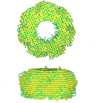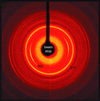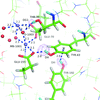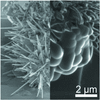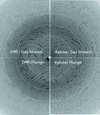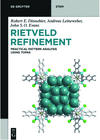issue contents
October 2019 issue

Cover illustration: POWGEN: rebuild of a third-generation powder diffractometer at the Spallation Neutron Source [Huq et al. (2019). J. Appl. Cryst. 52, 1189-1201].
research papers
Open  access
access
 access
accessThe article discusses how theoretical crystal data are supplementing experimental data for simulation and prediction of structures of inorganic solids in the Inorganic Crystal Structure Database.
A robust method is presented for the resolution of small-angle scattering problems featuring a structure factor. It is based on the local monodisperse approximation and the expectation-maximization algorithm.
A method is described for reconstructing the shapes of protein molecules from X-ray solution scattering data, which involves the progressive confinement of a set of interacting volume-defining points to fit the expected protein volume. Tests with synthetic and experimental data demonstrate that the final distributions of points obtained using this approach correctly map out the protein envelope.
Solidifying in high magnetic fields is an effective way to control the crystallographic orientation of the primary and eutectic phases in a binary eutectic alloy.
The residual stress and piezoelectric performance of ZnO thin films under different annealing parameters are investigated. The amplitudes of the sample vibrations at different frequencies are measured by a pressure electron microscope.
Open  access
access
 access
access2D X-ray diffraction and vibrational spectroscopy are used to follow changes in bone remodelling due to different health conditions (pregnancy, lactation) and bone pathologies (phosphate deficiency) in mice.
Time-of-flight neutron diffraction of a manganese catalase cubic crystal with a = 133 Å was successfully performed using the IBARAKI biological crystal diffractometer.
PDB reference: 6kk8
This paper compares several well known methods for denoising orientation data with methods adapted from mathematical image analysis.
This work has developed, characterized and tested coating procedures for 3D printed droplet generators and also demonstrates sample injection in serial femtosecond crystallography with X-ray free-electron lasers to reduce the vast amount of sample wasted in these crystallography applications.
Open  access
access
 access
accessA cross-section analysis is presented of defects in ZnO nanospikes, investigated by means of transmission electron microscopy and defect simulation.
Shock-wave-induced crystallization in water samples is reported and the mechanism is discussed. The technique provides an alternative method of understanding the crystallization behaviours of different liquids and solid materials, and it can be used as a water purification method.
Open  access
access
 access
accessMethods for efficient data extraction for neutron spin-echo spectroscopy with multipixel area detectors and – at a pulsed neutron source – multiple time-of-flight wavelength bins are presented.
This paper aims to provide an approach for modeling the PDF pattern of nano-systems based on the reverse Monte Carlo algorithm. It presents in detail the theoretical derivation and demonstrates the general applicability of such an approach implemented in the RMCProfile package.
Download citation


Download citation


This work describes in detail the crystal structure of Mo-substituted lanthanum tungstates, determined through neutron diffraction and high-resolution X-ray diffraction as a function of temperature between T = 10 K and T = 298 K. Combined X-ray and neutron-diffraction refinements and electron-probe micro-analysis were employed to locate Mo atoms in the crystal structure of La5.4W1−yMoyO12−δ (0 ≤ y ≤ 0.2).
CCDC reference: 1937552
The reflectivity curves of polarized neutrons vary strongly as a function of the proton polarization of the film samples. It is demonstrated that detailed structural information on each surface and interface of a multilayer film sample can be obtained from these proton-polarization-dependent multiple reflectivity curves.
Synchrotron X-ray diffraction has allowed the determination of the microstructure evolution during linear heating in a single crystal of a metastable titanium alloy (Ti–15Mo). The results were compared with electrical resistance evolution. The dissolution of the ω phase during heating of Ti–15Mo with a heating rate of 5 K min−1 occurs by ω → β transformation rather than ω → α.
This study demonstrates how the parallax effect in area detectors impacts X-ray pair distribution function data, and a simple correction is proposed.
A major problem in characterizing the strain in non-planar structures such as nanowires is to resolve within a standard framework the interplay between the different contributions. This article reports an efficient nondestructive X-ray laboratory formalism that allows good control of the local examination, providing the strain mapping along the nanowire length and a quantitative description of the energy transfer inside the nanowire array, as well as an estimation of the structural defect densities.
A new model for the optics of a bent-crystal incident-beam monochromator such as a Johansson optic is presented. This model results in very high quality fits to powder diffraction peak shapes in the fundamental parameters approach.
A high-resolution small-angle X-ray scattering setup based on refractive optics and a variable sample position allows tuneable resolution to be achieved in both direct and reciprocal space. The setup is designed for the study of simultaneous structural ordering on the nano- and microscale.
Fine temperature-induced structural changes in halide perovskites are investigated by in situ X-ray powder diffraction measurements, by using structure-based pair distribution function refinement and unbiased analysis methods based on multivariate analysis.
A method is described for maintaining sample alignment to a high accuracy during in situ X-ray synchrotron investigations involving 3D mapping of crystal orientations, and application of the method to in situ deformation of samples of fine-grain-size aluminium is described.
Knowing the stress/strain state of hydrides is important to understand the stress-induced degradation mechanisms of components made of zirconium alloys. X-ray diffraction is used to evaluate such a strain state through a novel approach based on the interpretation of strain pole figures.
Open  access
access
 access
accessThe single-crystal elastic constants of polycrystalline titanium alloys have been determined using neutron and synchrotron powder diffraction.
Using the recently proposed spherical indexing algorithm for EBSD patterns, a novel methodology to automatically predict potential pseudo-symmetric or systematically mis-indexed orientations for an arbitrary crystal structure is proposed.
A time-resolved small-angle X-ray scattering study on the evaporation-induced structural evolution of the lamellar mesophase has been carried out.
A systematic study on atomic structures and migration mechanisms of interphase boundaries in a massive body- to face-centered cubic transformation of a Cu–Zn alloy is carried out.
Open  access
access
 access
accessThis work describes the design principles and upgrade of the neutron powder diffractometer POWGEN at the Spallation Neutron Source.
Variant selection occurring in red gold under stress during the A1 → L10 transformation is analysed with the electron backscatter diffraction technique, modelled using distortion matrices and quantified with the maximal work criterion.
Open  access
access
 access
accessThe program LSITESYM of the Bilbao Crystallographic Server (https://www.cryst.ehu.es), which establishes symmetry relations between localized and extended states in crystals with layer symmetry, is presented. The utility of the program is discussed and illustrated with several examples.
cryocrystallography papers
Open  access
access
 access
accessGas stream cooling at 100 K is found to yield lower mosaicity than plunge cooling into liquid nitrogen at 77 K for several different protein crystals.
short communications
The effective neutron cross section of hydrogen in four simple organic molecules has been determined via direct transmission measurement of the total cross section in the energy range 3 meV to 10 eV. The data show a linear dependence on wavelength over a very limited range, requiring a sigmoidal four-parameter fit in order to describe the entire range of wavelengths accessible in the neutron experiment.
book reviews
Free 

Free 

Free 



 journal menu
journal menu











